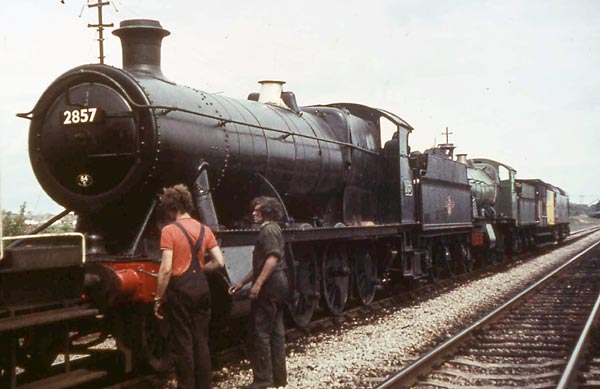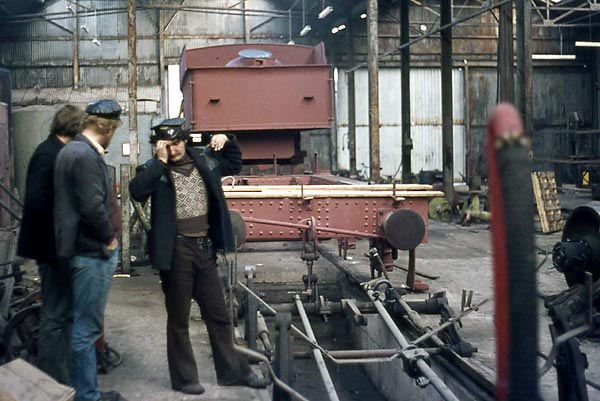History of 2857
The prototype of this design, the first locomotive of the 2-8-0 wheel arrangement in Britain, was built at the GWR Swindon Works in 1903. This was a time when the Great Western Railway was producing a range of standard locomotives, designed by the railway’s Chief Mechanical Engineer, George Jackson Churchward, which were unquestionably the most technically advanced in Britain for their time. Several design details, particularly the method of joining the pair of cylinder castings in the middle of the engine, the long travel valves, the tapered boiler and the generous bearing surfaces, were absorbed from contemporary American practice, and were considered revolutionary in Britain at that time. In producing a standard range of engines, Churchward was careful to produce standardised parts such as the boiler, which could also be used across several locomotive types. For instance the boiler on 2857, the Swindon ‘Standard No.1’, was common to his main 2-cylinder passenger engine, known as the ‘Saint’, and to his 4-cylinder express engine, the ‘Star’. He also proposed a versatile mixed traffic variant using this ‘No.1’ boiler, which was not introduced until a generation later and was known as the ‘Grange’, a highly successful design of 2-cylinder 4-6-0, well liked by their crews.
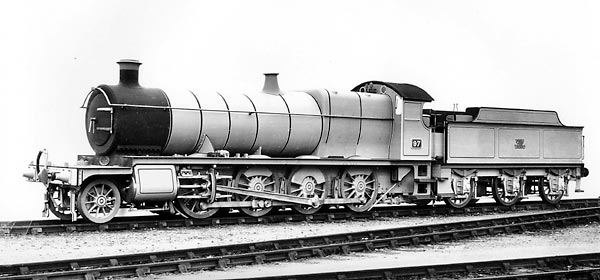
During extensive trials 2857’s sister loco 2808 hauled a 107 wagon train of 2012 tons from Swindon to Acton in 1906 and established a new haulage record for a British steam locomotive. By 1919, 84 of these 2-8-0s had been constructed at Swindon: No. 2857 was completed there in April 1918 at a cost including tender of £5,948. After a lapse of nearly twenty years construction of the class was resumed and another 83 engines were produced between 1938 and 1942, incorporating minor modifications. This class of 167 engines was responsible for hauling most of the long distance heavy freight trains on the GWR and British Railways (Western Region) for sixty years, a remarkable achievement.
During a working career of 45 years, No. 2857 recorded a total mileage of 1,276,713 miles and, to judge from the depots to which she was allocated, must have operated over virtually all the GWR routes on which she was permitted to run. She was delivered new to Salisbury GWR depot and then moved successively to Pontypool Road, Aberdare, Old Oak Common, Newton Abbot, back to Aberdare and to Pontypool Road, then Severn Tunnel Junction, Pontypool Road again, Cardiff Canton, Plymouth Laira, Stourbridge, Banbury, Tyseley, Chester, Pontypool Road for a fourth time, Tyseley again, Swindon, Newport Ebbw Junction, Severn Tunnel Junction again before withdrawal from Neath depot in April 1963.
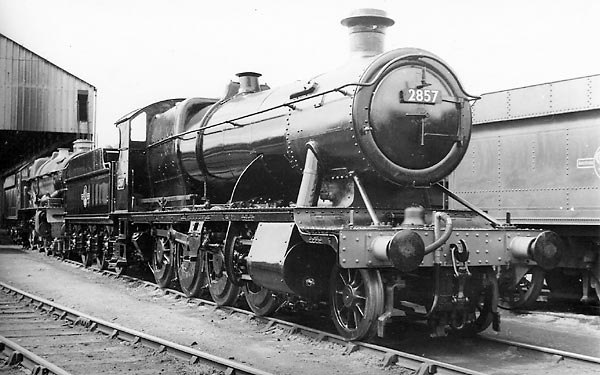
The GWR 2-8-0s were displaced from the heaviest work by the introduction of the BR Standard 9F 2-10-0s and, particularly in South Wales, by the class 37 English Electric Type 3 Co-Co diesel electrics, their situation not being helped by a general decline in rail freight traffic. No. 2857 was stored for six months before being sold as scrap to Woodham Brothers at Barry Dock in South Wales. Woodham Brothers scrapyard was a unique institution in the history of steam preservation in Britain, in that around 200 engines were stored while the company cut up scrap coal and other wagons which were seen as less economical in storage space. Gradually non-ferrous fittings and pipework were stolen until Woodhams decided to remove it all for security. All preservationists were therefore faced with the challenge of replacing non ferrous components from scratch for any locomotive purchased. Purchase of a locomotive from Barry scrapyard was clearly not a task to be undertaken lightly and so for many engines this looked like the end of the line.
The ‘28XX Fund’ was launched by a group of Severn Valley Railway members in late 1971, when the price of a “second-hand” ‘28’ was £3,500. No. 2857 was selected as being in the best all-round condition out of the fourteen of the class remaining in Woodham Brothers Barry scrapyard. By July 1972 the familiar type of appeal for donations and the purchase of shares had brought in a mere £700, £500 of which had been invested by one shareholder. Evidently ‘28’s’ were not on many steam-lovers list of preservation priorities! By the beginning of 1973 the £1,000 mark had still not been reached, but the cost of a ‘28’ was now £4,000, plus £400 for the newfangled VAT. With the price rising faster than the funds were being raised, Lesson One was being learned: sufficient money would not arrive on our doorstep purely as a result of appeals.
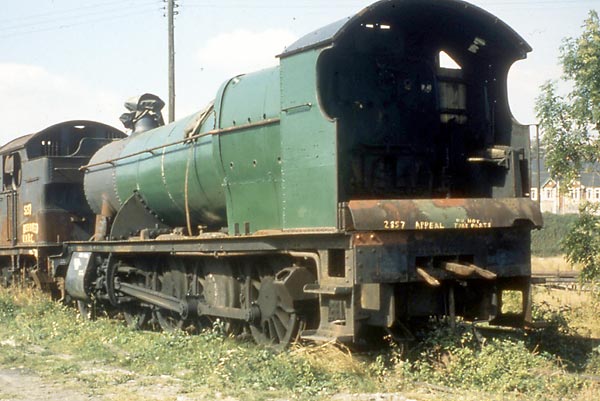
After a general meeting decided against winding the scheme up altogether, a sales stand was established and a steady income started to trickle in. Before long, though, the price had leapt up still more, this time to £5,250 + £525 VAT, and a further increase to £6,500 + £650 VAT was scheduled to take place on 1st June 1974.
A desperate appeal was sent to all shareholders of what was now the ‘2857 Society’, begging them to buy extra shares, take out standing orders, make donations or give interest-free loans. Happily the response was amazing, and enabled no. 2857 to be purchased on 20th May 1974, just before that threatened price rise. However, another year of fund raising passed before she was moved by rail to the Severn Valley Railway in convoy with Collett Mogul no. 7325, arriving on 20th August 1975.
Over the years we have tried all manner of fund raising schemes, from discos to rail tours, from jumble sales to waste paper collection, but our best commercial venture has been the production of high quality house numberplates in the form of solid brass half-scale GW cabside plates, these being warmly recommended in a review in ‘Steam Railway’ magazine.
